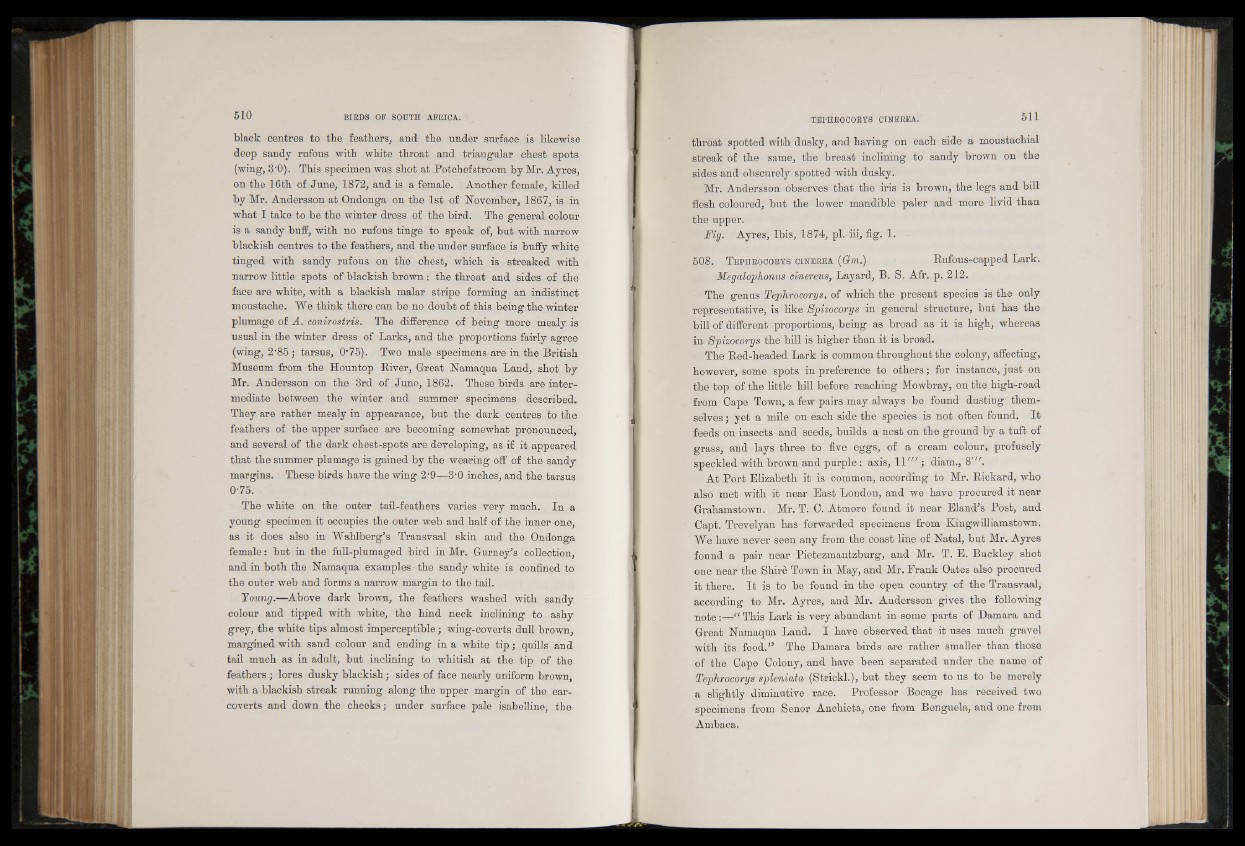
black centres to the feathers, and the under surface is likewise
deep sandy rufous with white throat and triangular chest spots
(wing, 3-0). This specimen was shot at Potchefstroom by Mr. Ayres,
on the 16th of June, 1872, and is a female. Another female, killed
by Mr. Andersson at Ondonga on the 1st of November, 1867, is in
what I take to be the winter dress of the bird. The general colour
is a sandy buff, with no rufous tinge to speak of, but with narrow
blackish centres to the feathers, and the under surface is buffy white
tinged with sandy rufous on the chest, which is streaked with
narrow little spots of blackish brown: the throat and sides of the
face are white, with a blackish malar stripe forming an indistinct
moustache. We think there can be no doubt of this being the winter
plumage of A. conirostris. The difference of being more mealy is
usual in the winter dress of Larks, and the proportions fairly agree
(wing, 2-85; tarsus, 017 5 ). Two male specimens are in the British
Museum from the Hountop River, Great Namaqua Land, shot by
Mr. Andersson on the 3rd of June, 1862. These birds are intermediate
between the winter and summer specimens described.
They are rather mealy in appearance, but the dark centres to the
feathers of the upper surface are becoming somewhat pronounced,
and several of the dark chest-spots are developing, as if it appeared
that the summer plumage is gained by the wearing off of the sandy
margins. These birds have the wing 2‘9—3'0 inches, and the tarsus
0 -7 5 . •
The white on the outer tail-feathers varies very much. In a
young specimen it occupies the outer web and half of the inner one,
as it does also in Wahlberg’s Transvaal skin and the Ondonga
female; but in the full-plumaged bird in Mr. Gurney’s collection,
and in both the Namaqua examples the sandy white is confined to
the outer web and forms a narrow margin to the tail.
Young.—Above dark brown, the feathers washed with sandy
colour and tipped with white, the hind neck inclining to ashy
grey, the white tips almost imperceptible; wing-coverts dull brown,
margined with sand colour and ending in a white tip ; quills and
tail much as in adult, but inclining to whitish at the tip of the
feathers ; lores dusky blackish; sides of face nearly uniform brown,
with a blackish streak running along the upper margin of the ear-
coverts and down the cheeks; under surface pale isabelline, the
throat spotted with dusky, and having on each side a moustachial
streak of the same, the breast inclining to sandy brown on the
sides and obscurely spotted with dusky.
Mr. Andersson observes that the iris is bi’own, the legs and bill
flesh coloured, but the lower mandible paler and more livid than
the upper.
Fig. Ayres, Ibis, 1874, pi. iii, fig. 1.
508. T e phrocorys c in er ea (Gm.) Rufous-capped Lark.
Megalophonus cinereus, Layard, B. S. Afr. p. 212.
The genus Tephrocorys, of which the present species is the only
representative, is like Spizocorys in general structure, but has the
bill of different proportions, being as broad as it is high, whereas
in Spizocorys the bill is higher than it is broad.
The Red-headed Lark is common throughout the colony, affecting,
however, some spots in preference to others; for instance, just on
the top of the little hill before reaching Mowbray, on the high-road
from Cape Town, a few pairs may always be found dusting themselves
; yet a mile on each side the species is not often found. It
feeds on insects and seeds, builds a nest on the ground by a tuft of
grass, and lays three to five eggs, of a cream colour, profusely
speckled with brown and purple : axis, 11"'; diam., 8'".
At Port Elizabeth it is common, according to Mr. Rickard, who
also met with it near East London, and we have procured it near
Grahamstown. Mr. T. C. Atmore found it near Eland’s Post, and
Capt. Trevelyan has forwarded specimens from King will iamstoWn.
We have never seen any from the coast line of Natal, but Mr. Ayres
found a pair near Pietezmantzburg, and Mr. T. E. Buckley shot
one near the Shire Town in May, and Mr. Frank Oates also procured
it there. It is to be found in the open country of the Transvaal,
according to Mr. Ayres, and Mr. Andersson gives the following
note :—I This Lark is very abundant in some parts of Damara and
Great Namaqua Land. I have observed that it uses much gravel
with its food.” The Damara birds are rather smaller than those
of the Cape Colony, and have been separated under the name of
Tephrocorys spleniata (Strickl.), but they seem to us to be merely
a slightly diminutive race. Professor Bocage has received two
specimens from Senor Anchieta, one from Benguela, and one from
Ambaca.